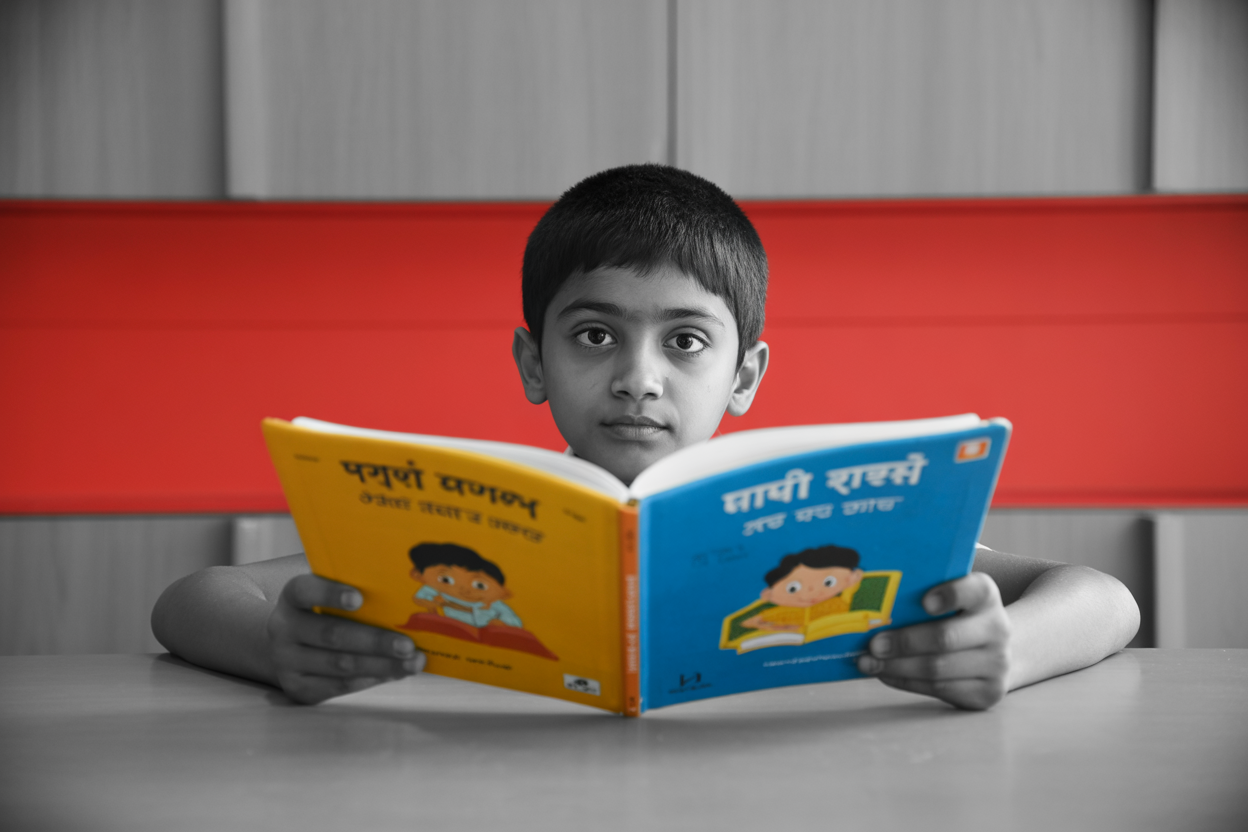- December 10, 2023
- by Educational Initiatives
- Blog
- 0 Comments
In this globalized world, accessing information has become convenient. This has allowed for overall exposure to global trends and language learning opportunity for students. With access to information and increased exposure comes the need for more learning content. Child-friendly, accurate learning content is either created or is made available through translations from other languages. After all, language learning also requires the ability to comprehend information that the literature in each language can bring a very different learning.
At Educational Initiatives, since we work with multiple states and different demographics, the processes and needs to have validated content across languages have been set up. Translation is one of the key process steps for two components. First, our regional assessments where we wish to equate the scores and hence want test item comparability. Second, for our educational content which is often created in one language and made available to more children through translation. This blog shares some of our experiences with the translatability of the text and when the adaptation can be ‘too much’ in case of test item translations and in reading content. The blog will also touch upon the need to validate the translations and align it to the objective.
Translation is both art and science. It balances between two extremes of making the text completely like target language and thus losing original complexity and of keeping the translations so loyal to the source language that it brings construct artificiality.Thus, some rigorous translations often leave the reader feeling vague and unclear about the text. The art lies in sticking to the principles of translation along with understanding cultural nuances.
It is important to remember that translation is the transfer of meaning from one language to another. The Hindi word Bhavanuvad (capturing the intent of the text of the target language) or Gujarati word Bhashantar (capturing the intent with a change in language) rindicate how translation is more about holding onto the essence of the text than the exact match of words used in the source language. Different languages also have different grammar, different word orders, sometimes even words for which other languages do not have any equivalents. Even within the same language when some words are used in a scientific/ technical way, they are represented by a different word than a colloquial usage of the same word.
Translating Reading content:
Both intensive and extensive reading build a child’s ability to read, retain and retrieve information during comprehension and conversations. Intensive reading is the reading undertaken by a child of a short text and this is generally done under the supervision of a teacher. Extensive reading, on the other hand, involves rapid and longer readings for general understanding. Thus, as per Carrel and Carson, Intensive Reading is more text-focused and extensive reading is more meaning-focused.
Stories or information relevant to a child can make good reading material for extensive reading and passages from the same can help in designing reading- comprehension exercises. While the folklore is rich and filled with the local stories and literature, translation allows us to merge the very different universes of stories and perspectives on stories by making them available in the target language.
When translating longer texts like stories, cultural contexts need to be kept in mind. One should, as much as possible, resist the urge to localise or simplify the context based onthe mere assumption of making it child-friendly. While it is important to have language lucidity, oversimplification or change of the context completely can make the text lose its essence. For the translation of stories across languages, we do make the contextual changes for names and places, only when it is not affecting the setting or the plot of the story.
| Original Text | Translated text |
| A small boy called Johnny1 always wanted to show that he was clever. One morning he decided to play a trick on the barber. He went to the barber’s shop and sat on the chair against the mirror. The barber said, “Yes, Johnny?”2 Johnny said in a strict voice, “Will you please shave my beard?” The barber knew that Johnny was playing a trick on him. But he gently said, “I will surely do so, Johnny.”3 The barber then puts a piece of cloth around Johnny’s shoulders. He also put soap on his face. Then he got busy with some other work. Johnny waited for quite a long time. Waiting with soap all over his face was difficult. He shouted at the barber, “Why do you keep me waiting?” The barber smiled very sweetly and said, “I’m waiting for your beard to grow.” | जतिन1 नाम का एक छोटा-सा लड़का हमेशा यह दिखाना चाहता था कि वह बहुत चालाक है। एक सुबह उसने नाई के साथ शरारत करने की सोची। वह नाई की दुकान पर गया और आईने के सामने कुर्सी पर बैठ गया। “क्या बात है जतिन?” नाई ने पूछा।2 “क्या आप मेरी दाढ़ी बना सकते हैं?” जतिन ने कड़क आवाज़ में पूछा। नाई ने जतिन के कंधों को कपड़े से बाँधा और उसके गालों और ठोड़ी पर साबुन लगा दिया। फिर वह किसी और काम में व्यस्त हो गया। चेहरे पर साबुन लगाकर इंतज़ार करना मुश्किल था। जतिन ने बहुत देर तक इंतज़ार किया, फिर वह नाई पर चिल्लाया, “आप मुझे इंतज़ार क्यों करा रहे हैं?” नाई बहुत प्यार से मुस्कुराया और बोला, “मैं तुम्हारी दाढ़ी बढ़ने का इंतज़ार कर रहा हूँ।” |
| As seen here, while the story length and complexitiy are maintained, a word-to-word translation has not be done. E.g. as highlighted as 2 & 3 in the passage, the sentences require to be translated to meet the colloquial conversational needs of the target language. Here, the translator has not translated I will surely do so to मैं ज़रुर करुँगा. It has been translated to मैं बना दूँगा जतिन to meet the language need for a verb for shaving. Depending on the age group, the names can also be changed to suit the more common names in the source language. However, as the age group increases, retaining the original names can be one way of giving the reader a perspective into the literature world of the source language. | |
Another challenge can come in translating the kinship terms, idioms or using some phrases in a literal sense. Rather, it is perfectly fine to retain the terms or phrases while translating if they do not exist in the target language. Or it is ok to coin a new powerful word in the target language. One famous example is of Satyajit Ray who in his Feluda series used the term ‘satellite’ for the ‘sidekick’. It was received so well by Bengali readers that it become a new word in Bengali literature (now even extended beyond the region).
As Arunava Sinha, one of the renowned Bengali translators shares in one of the web-interactions that we assume that the child wants to read the literature of their age gropu and hence simplify it. However, often, a 10-year-old wants to read the text created for a 13-15 year old. That’s because, at every age, the child believes to have known what he/she is supposed to understand well. The need to understand and grow up is very strong and that also influences the choice of reading at that age.
Translating Test Items:
Each test item is designed with a very specific testing objective. Translating them in a literal sense can defeat the objective and make the item redundant. If the testing objective is compromised, the validity of the test, which is an important attribute of a good test can be lost. Hence, translation of test items is a complex process. Along with the testing objective, especially in subjects like Language what also needs to be kept in mind is the difficulty level of the question, age-appropriateness of the translation and curriculum alignment.
| Original Question | Translation |
| Seema gave her friend a gift. She asked her friend to rearrange the missing letters of the alphabet on the box to find out what was inside.
Identify the word.
| सीमा ने अपने मित्र को जो वस्तु उपहार में दी उसका नाम बक्से पर लिखे अक्षरों में छिपा है।
वह शब्द पहचानिए। A: रुमाल B: किताब C: थैली D: तस्वीर |
| Explanation: In the above question example, if the translator does the exact translation without understanding what the question is trying to test, the question can be wrongly translated. In this case, it can be seen that the translator has understood that the idea is to check for the ability of a child to create words when jumbled letters are given. The words chosen here in Hindi are also grade appropriate. | |
| Original text |
| Fill in the blanks with the correct options. It was ____ first time out of the cage. ____ about time it happened.
|
| Explanation: The above question tests whether the child can use its and it’s correctly for a given sentence. This is a grammatical feature which is exclusive to English. Hence, such questions cannot be translated. A similar, grade specific grammatical concept will have to be discussed and picked up through a discussion with an EI team member. |
This brings in another level of complexity in the translation of test items. When a particular test item is required to be used across different languages, another process of harmonization is required to be carried out. Harmonization allows for ensuring that the test item, across different languages, holds the same testing objective, difficulty level and complexity. This is a must-do when the data is required to be equated.
| Original text | Literal translation | Meaningful translation |
| The shaded part in the figure below represents a fraction. Which of the following figures represents the same fraction as the one above? | नीचे चित्र में दिखाई देने वाला आच्छादित हिस्सा एक भिन्न का प्रतिनिधित्व करता है। निम्नलिखित चित्रों में से कौन सा चित्र उपरोक्त चित्र की तरह एक समान भिन्न का प्रतिनिधित्व करता है? | नीचे दी गई आकृति का छायांकित(रंगा हुआ) हिस्सा एक भिन्न दर्शा रहा है। इनमें से किस आकृति में वही भिन्न दर्शाई गई है जो कि ऊपर दी गई आकृति में है? |
| Example: In the above question translation, it can be seen that when the translation is literal, it does not only sound complex, it becomes longer than what is needed. The child ends up spending more time reading the question and often finds it more confusing to comprehend. When the instruction is clear, the ability of the child to arrive at the answer depends only on their ability to apply the concept. | ||
Back-translations have been found a useful way to ensure that the translation captures the essence. The translation in the target language is back translated to the source language by an independent person. If the objective of the translation remains intact in the back translation process, it back be
Thus, translation is a very important step in reading content as well as in creating items in various languages. The validity of translation requires utmost care and can be achieved by various methods used in combination like,
- Double-translation: translation done by two people and compared to check if there is a close match
- Reverse-translation: translation from source to target and then from target to source language by the same person
- Back translation: translation from target language, back to the source language by an independent translation
- Harmonization: comparison of item complexity and testing objective across languages when the content is being translated in multiple languages
That’s why they say, translation is the most sincere way to understand what you are reading.
References:
Wilss, W. (1994) “A Framework for Decision-Making in Translation.” Target-international Journal of Translation Studies 6: 131-150.
Carrell, P.L., & J.G. Carson (1997) “Extensive and Intensive Reading in an EAP Setting”, English for Specific Purposes 16: 47-60.
Vaidya, G. K. (2015) “Content validation and rubric development of language tools tested in multi-state multi-language project: Challenges Faced” In: Proceedings of International Association of Educational Assessments, USA.
Adaptation and Translation guidelines for PISA (2012).





